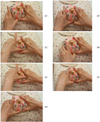1. Choi YJ, Kim MO. Effect of a breastfeeding management program on breastfeeding duration. Korean Journal of Women Health Nursing. 2007. 13:245–253.

2. Eum G, Sohn H, Kim H. Breast feeding rate and related factors in Busan. Journal of the Korean Society of Maternal and Child Health. 2007. 11:78–85.
3. Foda MI, Kawashima T, Nakamura S, Kobayashi M, Oku T. Composition of milk obtained from unmassaged versus massaged breasts of lactating mothers. Journal of Pediatric Gastroenterology and Nutrition. 2004. 38:484–487.

4. Harrison VC, Peat G. Significance of milk pH in newborn Infants. British Medical Journal. 1972. 4:515–518.

5. Joo JO. Impact of nipple and areola extensibility and ease of milk extraction during early postpartum period on nipple pain and continuation of breast-feeding. 2008. Seoul: Yonsei University;Unpublished master's thesis.
7. Konish K, Yoshidome A, Miyazaki F, Kumashiro M. The effect of oketani style breast massage on the autonomic nervous function in the early puerperal stage. Journal of Japan Academy of Midwife. 2004. 18:87–93.
8. Korea Institute for Human and Social Affairs. A survey on the fertility and familial health: Welfare of Korean in 2006. 2008. Seoul: Author.
9. Lee HS. Performance of breastfeeding by employed mother. 2001. Busan: Kosin University;Unpublished master's thesis.
10. Lee HW. The effect of breast nursing care of each milk physiology stage on the breast feeding practice. 1999. Seoul: Yonsei University;Unpublished master's thesis.
12. McDowell MM, Wang C, Kennedy-Stephenson J. Breastfeeding in the United States: Finding from national health and nutrition examination surveys, 1999-2006. National Center for Health Statistics Data Brief. 2008. 5:1–8.
13. Miller BF, Keane CB. Encyclopedia and dictionary of medicine, nursing, and allied health. 1987. Philadelphia: W. B. Saunders.
14. Morriss FH, Brewer ED, Spedale SB, Riddle L, Temple DM, Caprioli RM, et al. Relationship of human milk pH during course of lactation to concentrations of citrate and fatty acids. Pediatrics. 1986. 78:458–464.
15. Oketani S. Oketani's breast massage therapy. 1991a. Tokyo, Japan: Bong Hwang Dang Press.
16. Oketani S. The practices of oketani's breast massage therapy. 1991b. Tokyo, Japan: Bong Hwang Dang Press.
17. Park BI. The survey on the knowledge to breastfeeding of married nurses with Infant-toddler and actual state. 2001. Cheonan: Soon Chun Hyang University;Unpublished master's thesis.
18. Park SH, Koh HJ. Effect of breast-feeding education and follow-up care on the breast-feeding rate and the breast-feeding method-focused on home visit and phone counseling. Korean Journal of Women Health Nursing. 2001. 7:30–43.
19. Park SO. Effects of a breastfeeding support on the breastfeeding knowledge, attitude, level of Na+ within breast milk and continuing breastfeeding. 2004. Busan: Pusan National University;Unpublished doctoral dissertation.
20. Suh Y, Lee E. The effect of breast feeding promotion program on the changes in confidence towards the breast feeding practice. Journal of the Korean Society of Maternal and Child Health. 1998. 2:13–27.
21. Sung MH, Kim DH. Effects of breast-feeding education and continuous phone counseling on the promotion of breast-feeding compliance. Journal of the Korean Society of Maternal and Child Health. 2003. 7:167–178.
23. Yeo JH, Hong SC. The study on the knowledge, attitude and practice rate of breast feeding. Journal of the Korean Society of Maternal and Child Health. 2003. 7:155–165.
24. Yoo EK, Kim MH, Seo WS. A study on the rate of breast-feeding practice by education and continuous telephone follow-up. Korean Journal of Women Health Nursing. 2002. 8:424–434.





 PDF
PDF ePub
ePub Citation
Citation Print
Print





 XML Download
XML Download